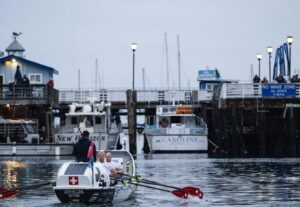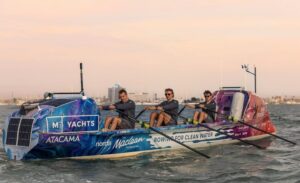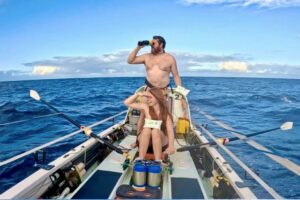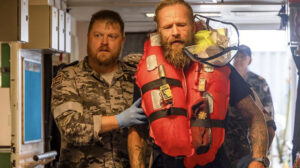This year, Michelle Lee became the first woman to row the Pacific Ocean alone. After an epic 240-day journey, she landed in Queensland, Australia on April 5.
Lee started her 14,000km row in Ensenada, Mexico on Aug. 8, 2022, three days after her 50th birthday.
Lee previously set the women’s speed record for rowing one million meters on a rowing machine (5 days, 21 hours, and 35 minutes). In 2019, she became the first Australian woman to row any ocean solo when she crossed the Atlantic during the Talisker Whisky Atlantic Challenge. Despite all this experience, nothing could have fully prepared her for this Pacific row.

Photo: Michelle Lee
A difficult start
Her row started slowly. For the first few weeks, headwinds and difficult currents plagued her. At one point it was so bad that she was in contact with her meteorologist every four hours to try and find the most efficient way forward.
Lee tried to keep her eye on the positives. During one storm, she decided to row regardless of the conditions because she was going stir-crazy in her cabin.
“I ended up rowing in 20-knot winds and big seas. It was so awesome. Like breaking new barriers. Now I know I can row in 20 knots. It was a confidence builder,” she said.
But rowing through the storms was not always possible. She had to contend with five hurricanes, four cyclones, and long periods trapped in her cabin. Cyclone Gabrielle caused her the longest stretch inside — a claustrophobic nine days. All she could do was sit on her para-anchor and listen to the waves crashing into her boat.

Photo: Michelle Lee
For a solo rower, one of the trickiest balancing acts is sleeping. With adverse currents and winds, you can spend all day rowing only to get pushed backward during a few hours of sleep. Lee used her para-anchor to reduce this, but losing miles was often inevitable.
Navigating the Great Barrier Reef
Lee’s journey proved difficult to the last. Two cyclones hit while she was crossing the Coral Sea. Lee was moving west but it was hard to predict which exactly port she would land in. Wind and strong outgoing tides pushed her off course.
Her landing was delayed several times and she had to carefully maneuver her way through the Great Barrier Reef.
“There are a lot of things that need to be organized for this, a fair bit of planning and strategy,” Lee wrote on her blog. “There’s a plan A, plan B, and plan C. It’s super technical for Roger, my weather router, to get me across the reef at the right time.”

The erratic purple line marks her actual route. Image: Michelle Lee
Lee spent days trying to navigate the reef and reach her finish line. She was rowing for six-hour stints, hoping to make Port Douglas. But in the end, conditions became so tricky that she was forced to move her endpoint 58km.
“The last section was a bit of a battle,” she told reporters.
Aside from the physical strain, Lee’s biggest hurdle was loneliness. Living in solitude for eight months is hard, and Lee admitted to many low points. To stay sane, she listened to 37 audiobooks, played her ukulele, and spoke to friends and family when possible.
“There have been long, long chats on the satellite phone. We’ve had a few tears and a lot of laughs together. We’ve been talking constantly,” one of Lee’s friends told ABC while they waited for her to land.

Photo: Michelle Lee
Dreams of an early finish dashed
Earlier in her journey, Lee was making such good progress that it seemed she would get to Australia at the end of February. This was far sooner than she had expected and it raised her hopes. A few cycles later, it was clear that such an early finish wasn’t going to happen. She couldn’t help feeling a little down.
Fortunately, the Pacific’s wildlife helped lift her spirits. The biggest highlight for Lee was when her boat became a creche for baby sharks. She had been trailed by two sharks for weeks and soon noticed four baby sharks swimming beneath her boat. The parents would leave them for periods before returning. Lee is convinced that after following her for weeks, they felt their babies were safe with her. Pretty soon there were dozens of baby sharks around her. “I have become the nursery. It’s very cute. Everyone is in harmony with each other,” she wrote.
One morning, Lee emerged from her cabin to find a shark thrashing around on the deck. Sadly, she was unable to help it back into the water. All she could do was wait for it to die before returning it to the sea.

Photo: Michelle Lee
Though she was alone on the water, Lee did have a land support team. She had a doctor on call to discuss ailments and a dedicated weather router to keep her updated on winds and currents. Lee says she could not have done the arduous journey without him. His information allowed her to maneuver around weather systems.
Setting out, Lee knew that the ocean itself would ultimately dictate the success or failure of the row.
“You’re just experiencing and witnessing Mother Nature in all her runway-ready, take-me-as-I-am, natural beauty. Some days she’s better than others and she certainly puts you through the paces,” she told Women’s Agenda.
Back in Australia, Lee is already planning future expeditions. “Say ‘yes,’ work the details out later. I’m excited for what’s to come.”






